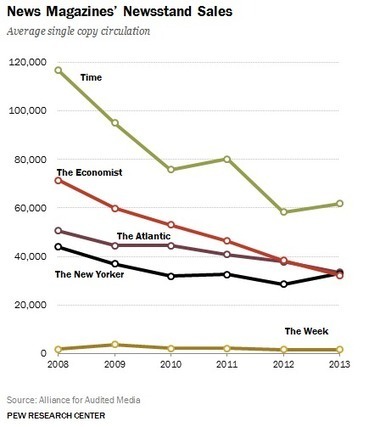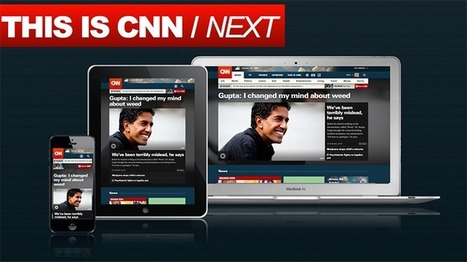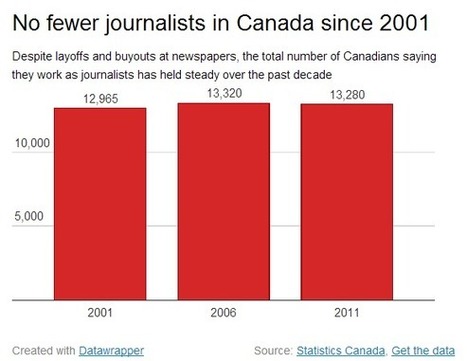 Your new post is loading...
 Your new post is loading...
It’s been a remarkable year for the nation, and its press. Transfixed by the Trump phenomenon, election anxiety has all but consumed us. But soon, what has felt like a national colonoscopy will soon be over, and the press will march (or at least step) forward. As we consider the most newsworthy U.S. press happenings of this year, let’s start projecting forward to 2017. Tronc may well disappear early into it, but in a sons-also-rise scenario, the Murdochs and the Sulzbergers maintain center stage, and the future of Gannett and GateHouse — two companies that collectively own almost one in five U.S. dailies — becomes even more important. Let’s take 10 storylines of 2016 and extend them into the year ahead....
Automated journalism is here to stay, according to a new report from Columbia’s Tow Center and research fellow Andreas Graefe. But what are the most efficient uses of this technology, and what are its limitations? What is it good for that news organizations might not have considered yet? How do readers respond to automated articles? How does the spread of automated journalism affect the way human journalists do their jobs?
The report explores some of those issues in depth, presenting several case studies (and allaying some fears of a robot takeover).
...Chief among the findings was that many young consumers craved more in-depth news but were unable or unwilling to get it. “The abundance of news and ubiquity of choice do not necessarily translate into a better news environment for consumers,” concluded the researchers in their final report. “Participants in this study showed signs of news fatigue; that is, they appeared debilitated by information overload and unsatisfying news experiences .
. . . Ultimately news fatigue brought many of the participants to a learned helplessness response. The more overwhelmed or unsatisfied they were, the less effort they were willing to put in.
”The idea that news consumers, even young ones, are overloaded should hardly come as a surprise. The information age is defined by output: we produce far more information than we can possibly manage, let alone absorb..
A 96-page internal New York Times report, sent to top executives last month by a committee led by the publisher’s son and obtained by BuzzFeed, paints a dark picture of a newsroom struggling more dramatically than is immediately visible to adjust to the digital world, a newsroom that is hampered primarily by its own storied culture.
The Times report was finalized March 24 by a committee of digitally oriented staffers led by reporter A.G. Sulzberger. His father, Times Publisher Arthur Sulzberger, fired Executive Editor Jill Abramson Tuesday, a decision that doesn’t appear immediately related to the paper’s digital weaknesses.
The report largely ignores legacy competitors and focuses on the new wave of digital companies, including First Look Media, Vox, Huffington Post, Business Insider, and BuzzFeed....
I got one of those digital wake-up calls last week when my obsession with data turned to mobile traffic. In April, we had the same number of readers visit our home page via smartphone as we did the desktop.
The same was pretty much true for our popular Billionaires List. We also delivered streams of headlines for mobile readers partly determined by their consumption patterns. Briefly, we even crossed the newest digital divide. During the first weekend of May, 51% of visits were mobile — 39% smartphone, 11.5% tablet. What’s it all mean? ...
The Pew Research Center’s Journalism Project has released its 11th State of the News Media report. A comprehensive “document,” it covers TV, newspapers, magazines, radio and digital.
I won’t try to summarize the full sweep of this “best of times, worst of times” report. However, below I’ve excerpted a few key findings and charts that provide a snapshot into where things stand in US journalism and news consumption....
...I should end the year on an upbeat note, shouldn’t I? But Time Inc. ruined it. The surrender of journalism to advertizing and public relations – not alliance with, but surrender to – was the biggest media story of 2013 that the media almost didn’t cover at all. But it’s right there in black and white, if buried on the slowest news day of the year:
Time Inc. will abandon the traditional separation between its newsroom and business sides, a move that has caused angst among its journalists. Now, the newsroom staffs at Time Inc.’s magazines will report to the business executives. Such a structure, once verboten at journalistic institutions, is seen as necessary to create revenue opportunities and stem the tide of declining subscription and advertising sales...
Hal Varian, Google’s chief economist, talked about the challenges facing the newspaper business in a recent presentation in Italy, and showed that he understands those challenges better than most media executives.
This is what UPI's 100 years of journalistic excellence has pathetically come down to.... - 4 of its top stories are about misbehaving celebrities. The other is about whether a naked photo that went viral was staged. - 4 of its top stories are about naked people; 2 of its top stories contradict each other. And considering that the 5th story could have been fact-checked by just watching the video in question, that means UPI ran a story for hits without even watching the video. - 3 of the stories are not even about Miley Cyrus, they’re about celebrity reactions to her routine....
...Today, the delivery of news is not so defined. Website, social media and digital platforms have profoundly changed not only how we get our news, but also what news we are getting. The comment section of online news stories are often more popular, or at least more entertaining, than the actual news story. The ability to “like” and “share” news now allows others to instantaneously watch or read what we are following.
As the number of online and social media offerings grows, we are sadly seeing the demise of newspapers. In 2011, 152 American newspapers ceased operations. Rapidly declining advertising revenues continue to be the industry’s core problem as the majority of us seek our news online.
Now, plans are in place for significant changes for CNN.com and CNN digital platforms. The channel will launch a redesigned website (see screenshots here) and install a back-end system that its editorial producers can utilize. This comes after the recent merging of their digital and television newsrooms into one entity. With a new emphasis on their talent, CNN anchors, reporters and writers will become more prominent, enabling the sharing of content across platforms....
In the wake of the Boston Marathon bombing one commenter called it a “watershed moment for social media” – but not in a good way. “Legions of Web sleuths cast suspicion on at least four innocent people, spread innumerable bad tips and heightened the sense of panic and paranoia,” wrote Ken Bensinger and Andrea Chang in the L.A. Times. In a similar post, Alan Mutter quipped that crowd reporting after the Boston Marathon went from critical mass to critical mess.
Recent events like Hurricane Sandy and the Boston marathon bombing have cast a harsh spotlight on the brave new world of breaking news and highlighted the critical need for better tools and techniques for verifying and making sense of the flood of information these events produce. This has all played into the ongoing debate about whether the Internet and new technology erode our standards and our trust in newsgathering....
Rebecca Jarvis, business and economics correspondent for CBS News, discusses the current state of journalism, what the future holds, and why companies are scooping up journalists to create rich content for their brands.
The NYT’s multimedia project Snow Fall was a huge success, attracting big audiences and lots of plaudits. ...Snow Fall (and other such attempts) represent a great opportunity and the future for news organizations like The New York Times, especially as they are right now in a losing battle for attention with upstart competitors that include everyone from BuzzFeed to The Huffington Post. If you are the New York Times management, it is time to take a gamble: spend $25 million on creating 100 Snow Fall-like projects.... And in exchange, it got a few million page views, but I am guessing they also built a nice backend infrastructure to create more such projects. As a result, the next Snow Fall is going to cost less, with most future spending going to the creative: words, photos, other multimedia elements and design. So what will the Times (or someone like them) need to get it done? Simply put, a departure from the incumbent thinking, embracing today’s reality and re-imagining the work flow of a big city newspaper. In other words: Re-imagining its business model to factor in the reality of today’s world and forget the legacy of newsprint.Create a new breed of “producer” who can switch between Excel and content.Create a whole new breed of a journalist — one who has old-school values but also the ability to tell a story that works in many mediums of today.Build an editorial creative machine that works differently from a print-centric editorial group....
|
What if, in the mad dash two decades ago to repurpose and extend editorial content onto the Web, editors and publishers made a colossal business blunder that wasted hundreds of millions of dollars? What if the industry should have stuck with its strengths—the print editions where the vast majority of their readers still reside and where the overwhelming majority of advertising and subscription revenue come from—instead of chasing the online chimera? That’s the contrarian conclusion I drew from a new paper written by H. Iris Chyi and Ori Tenenboim of the University of Texas and published this summer in Journalism Practice. Buttressed by copious mounds of data and a rigorous, sustained argument, the paper cracks open the watchworks of the newspaper industry to make a convincing case that the tech-heavy Web strategy pursued by most papers has been a bust. The key to the newspaper future might reside in its past and not in smartphones, iPads and VR. “Digital first,” the authors claim, has been a losing proposition for most newspapers....
Dear budding journalist,
Thanks very much for your email! I’m always happy to meet just about anybody, and would love to find some time to have that coffee with you.
Of course I’m also very flattered by the lovely things you said about me, and about how you’d love to have a career in journalism where you might be able to do the kind of thing that I do.
But you won’t. The job I’m doing now was inconceivable when I was your age, and, similarly, if you’re lucky enough to have done well in this industry by the time you’re my age (I’m 42), then you’ll almost certainly be doing something which almost nobody today could foresee....
We don’t typically write about intra-newsroom politics at Nieman Lab, leaving that to Manhattan’s very capable cadre of media reporters. But Abramson’s removal and Dean Baquet’s ascent has apparently inspired someone inside the Times to leak one of the most remarkable documents I’ve seen in my years running the Lab, to Myles Tanzer at BuzzFeed.
It’s the full report of the newsroom innovation team that was given six full months to ask big questions about the Times’ digital strategy. (A summary version of it was leaked last week, but this is the big kahuna.)
For a moment, let’s not focus on the delicious irony of Buzzfeed breaking the second biggest news about The New York Times this week. The site -- which many a Times staffer probably sniffs derisively at -- uploaded the paper-of-record’s entire 91-page “Innovation Report” that calls for de-emphasizing print in favor of a more sophisticated approach to digital. If you’re in digital, it’s even more intriguing than the news on Wednesday that executive editor Jill Abramson had been unceremoniously shown the door.
More than anything else, the report points to the Times’lackluster, scattershot approach to digital innovation, particularly in audience development, an imperative when so much content and readership comes from the act of sharing. In one of its many trenchant-but-obvious observations, it points out that “our digital content needs to travel on the backs of readers to find new readers.”...
Most journalists don't like chasing traffic -- or at least, they won't admit to it. Is that snobbery, arrogance, or a smart business decision?
As the American Journalism Review reported, in a piece called “No Analytics for You: Why The Verge Declines To Share Detailed Metrics With Reporters,”the editors at The Verge simply don’t want their writers thinking about traffic.
What’s more, The Verge is not alone in this practice. Re/code, a tech site run by Kara Swisher and Walt Mossberg, the longtime Wall Street Journal tech columnist, also won’t share traffic stats with writers.
MIT Technology Review holds numbers back too.“We used to show the writers and editors traffic, and told them to grow it; but it had the wrong effect. So we stopped,“ says Jason Pontin, CEO, editor in chief and publisher of MIT Technology Review. ”The unintended consequence of showing them traffic, and encouraging them to work to grow total audience, is that they became traffic whores. Whereas I really wanted them to focus on insight, storytelling, and scoops: quality.”...
Last month, venture capitalist Marc Andreessen posted what, in his view, was the future of the news business. Reactions were varied, but everyone had one. I joked that my entire Twitter stream was people replying to Andreessen as he has very publicly thrown himself into the future of news conversation.
We need new voices in this discussion like Andreessen, but his post was too… nice. I’d bet he left his more candid insights out. After the post, I found myself wishing someone would share more actionable observations from the industry.
So, here’s my take. Each one of these could be their own essay. Please argue with me....
Why are newspaper opinion columnists so consistently baffled by the politics, technologies, and social mores of the 21st century? We've crunched some data, and we think we've figured out the answer: They're old as hell.
2013 essay excerpted from BU professor Chris Daly's book...
The word “crisis” often comes up when talking about journalism in the U.S. and throughout the world: Dropping ad revenue, falling circulation, failed efforts to retool old models to fit a changing media landscape. As the blogosphere and Twitter rise, more opinionated kinds of media coverage push back against the longstanding ideals of impartiality and objectivity, and even the once sacrosanct authority of mainstream journalism is called into question.
But as many journalists, authors and researchers have noted, U.S. journalism has been in transition since its birth, from early broadsides of the revolutionary era through the disruptive entries of radio, television and now the Internet. In his 2012 book, Covering America: A Narrative History of a Nation’s Journalism, author and Boston University journalism professor Christopher B. Daly places the current state of journalism within its recent historical context. Below is an essay based on the book....
The New York Times is in the Snowden game.The paper — which NSA leaker Edward Snowden deliberately avoided over his fear that it would cooperate with the United States government — is now working with the Guardian on a series of stories based on documents that detail National Security Agency cooperation with its British counterpart, the Government Communications Headquarters, known as GCHQ.
"In a climate of intense pressure from the UK government, The Guardian decided to bring in a US partner to work on the GCHQ documents provided by Edward Snowden," Guardian spokeswoman Jennifer Lindenauer said in an email. "We are continuing to work in partnership with the NYT and others to report these stories."...
Chad Skelton does a good job of explaining it. There are just as many journalists working in Canada today as there were a decade ago, according to data from Statistics Canada....
When it comes to political scandal, why is the media is so out of step with its audience?
Spitzer and Weiner, with their cohorts around the country, are a slap in the media's face. Scandals, after all, are largely media created. You can hardly have a scandal without the media treating it as scandal — Spitzer's and Weiner's being among the tastiest of recent years.
There's a vested interest here. The media is defending its own work. The easy rehabilitation of the badly behaved refutes, if not the facts, certainly much of the media's damnation.While the media has been the instrument of running the offenders out of office, the public wants them back....
On June 6, 2011, Scott Pelley took over as anchor of the CBS Evening News, his tenure following Katie Couric’s five-year run. The once-dominant newscast had fallen to third place behind NBC and ABCduring the end of Dan Rather’s reign, and Couric’s stint saw the broadcast fall to record ratings lows. While still No. 3 among the Big Three, the CBS Evening News With Scott Pelley has seen significant growth since the Texan took over after a long run at sibling 60 Minutes.
In the past year, the 6:30 PM broadcast has added 490,000 viewers, the largest annual increase for the network’s evening news in 15 years and the best among the broadcast news rivals since 2002. Overall, the CBS Evening News is up 12% in viewers since Pelley’s debut. Just before his second anniversary in the anchor chair, Deadline spoke with Pelley about the relevance of cable news and why so many mistakes are getting on the air....
|



 Your new post is loading...
Your new post is loading...


































Ken Doctor has storylines that will still be interesting in 2017..